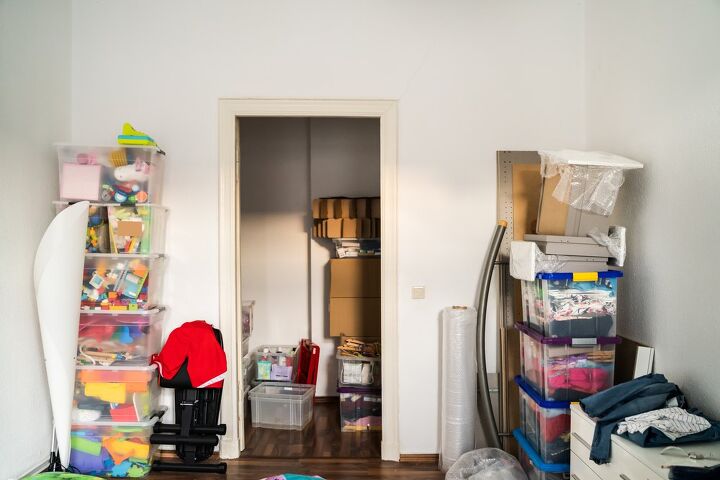7 Tips To Rescue Yourself From Overwhelming Clutter

Clutter tends to create chaos in your physical and mental space, even when you don't realize it. The more stuff that piles up, the more stress you feel, often freezing you in your tracks. If your clutter overwhelms you, it can be hard to find the motivation to do something about it.
If you’re easily overwhelmed, don't try to declutter the entire house at once. Start with easy items you don't have to think much about and sort everything into broad categories. Ask a friend for help, use a timer, and incorporate the 20/20 rule into your decision-making. Set difficult items aside for later.
You may think decluttering is too stressful, so you push it aside for another day that never comes. But when you step back, you realize keeping the clutter causes far more stress than doing something about it. Recognizing this makes the process more accessible. It's possible to reduce the overwhelming sensation that comes with paring down your belongings.
Why Does Clutter Stress Me Out?
Some people seem to thrive on clutter. They collect everything from stamps to dryer lint and swear it makes them happy. But look closer, and you'll discover that more often than not, when there's too much stuff, it affects people in many ways.
Clutter stresses you out for several reasons. It reminds you of unfinished business, distracts you from what you want to do, and can make you feel embarrassed. Clutter also hinders your productivity, since it takes you longer to find what you need and get stuff done.
7 Ways To Make Decluttering Easier
If you're overwhelmed by clutter and don’t know how to start, use these decluttering tips to approach the process one step at a time.
1. Start With The Easiest Items
Take about 10 to 20 minutes to walk through your home and target easy items. It doesn’t matter what it is; if you know within seconds that you don’t want it, get rid of it. Whether it’s a sweater, a chair, a sofa, a book, or an old vase, it’s fair game.
Don’t worry about thinking you have to finish in one area before moving on to the next. You may already have a few items popping into your head as you’re reading this.
Once you identify an object as one that’s going bye-bye, get it out of the house right away. You’ll get instant gratification and see quick results that will motivate you to keep going.
2. Consider The Five-Things Method
Licensed therapist KC Davis recommends viewing the mess in your house in a different way. Instead of seeing the clutter as a bunch of individual items to think about, scale it back a bit. Davis suggests that everything piled up in your home fits into one of only five categories: trash, laundry, dishes, things with a place, and things without a place.
It’s a great way to get started because it removes overthinking things. When you pare down the number of categories, it reduces decision fatigue and the likelihood that you’ll give up out of frustration or exhaustion.
In a nutshell, the Five Things Method says to go through a space (one space or room at a time) and simply pull out all of the trash first. Next, grab dirty dishes, put them in the kitchen sink, and pull all the laundry into a pile. Don’t worry about washing anything at the moment. This step is just about cutting through the clutter without burning out.
After removing trash, dishes, and laundry, you’re left with things with a place and things with no home. Put items with a place where they belong. Now, you only have the items without a place. These are the only things you need to make decisions about, deciding what will stay and what will go.
3. Remember The 20/20 Rule
As you go through the items awaiting their fate, some things will be no-brainers (unless you already eliminated them in step number one). For the things that pose more of a challenge, keep the 20/20 rule in mind to avoid overwhelming decisions.
You don’t want to end up with paralysis by analysis, so it’s important to keep moving forward. The 20/20 rule simply means if you can find the item within 20 minutes for under $20, get rid of it. You won’t waste precious time and brainpower stressing when you approach objects from this perspective.
4. Choose Donating Over Selling
Decluttering only works if you actually get things out of your house. It’s understandable to want to sell items and make some money, but be honest with yourself. Are you really going to take the time to post or list items for sale in a timely manner?
If the stuff ends up sitting in your living room for weeks while you try to sell it, it’s likely not worth the trouble. If the goal is to keep the process of getting rid of clutter from being overwhelming, donating is the favored option. When you’re willing to give things away for free, it’s a lot easier to get rid of them quickly.
5. Use A Timer To Pace Yourself
When you get on a roll decluttering, it’s easy to keep going and forget to take a break. But if you push full steam ahead without taking care of yourself, you’ll wipe out sooner rather than later. You’ll accomplish much more if you remember to take regular breaks to grab a snack, stay hydrated, get some fresh air, and rest.
Set a timer to remind yourself when it’s break time. Likewise, set a timer to remind yourself when the break is over, so you don’t get distracted from the task at hand. How often you should take breaks depends on you. Consider your schedule, how you feel, your response to decluttering and organizing, and what you want to accomplish.
For example, if you only have two hours to devote to decluttering and you know you get easily sidetracked, work for ten minutes, then take a three-minute break. If you can focus for longer periods, work for 30 minutes and take a 10-minute break. There’s no right or wrong answer when it comes to how you divide your time, as long as it works for you.
6. Ask A Friend For Help
Things are more fun with two, right? Ask a friend to lend a hand with decluttering, even if it’s just to keep you company. But be careful of the friend you choose to help you. If it’s someone who’s going to distract you more than help you, you won’t get too far with your project.
Choose someone good at keeping you focused, and who will provide an honest, unbiased set of eyes. You know the one. They’re the person who tells you like it is when you ask how you look in that shirt or if 40 pillows are too much.
7. Make A “Wait-And-See” Bin
After the items that are easy to let go and going through the 20/20 rule, what do you do about the things that linger? Things like the sentimental photos, mementos, or the jeans you think you’ll fit into soon, since you just started running.
Again, it’s about not becoming overwhelmed with clutter. You don't want anything to derail your efforts, so make a “wait-and-see” bin. Other names for this box might be “time will tell” or “check back later.” No matter what you call it, it works the same — it allows you to revisit certain items, say in three months.
If you need something from the bin before time is up, fine, dig it out, and then you have your answer. After three months, revisit the bin. If you never took anything out of it before this time, do you need it? The time away from the pieces often helps make the decision easier, since you know without a doubt you haven’t needed or thought about the item in months.
Don’t Let Decluttering Overwhelm You Any Longer
It’s time to take control of your clutter by overcoming being overwhelmed and reducing the number of decisions you need to make. Ask a friend to help you stay on track and start with things that require little thought.
Take things one step at a time, and pace yourself, so you don’t get burnt-out before you’ve barely begun. Every piece of clutter that leaves your home is a win, so celebrate it and let it motivate you to keep going.
Related Guides:

Stacy Randall is a wife, mother, and freelance writer from NOLA that has always had a love for DIY projects, home organization, and making spaces beautiful. Together with her husband, she has been spending the last several years lovingly renovating her grandparent's former home, making it their own and learning a lot about life along the way.
More by Stacy Randall













![Finishing Basement Without Permit [Is It Really Illegal?]](https://cdn-fastly.upgradedhome.com/media/2023/07/31/9070078/finishing-basement-without-permit-is-it-really-illegal.jpg?size=350x220)













